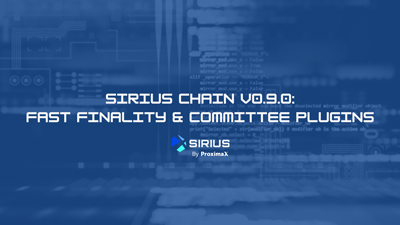
Sirius Platform Architecture

The Sirius platform consists of multiple servers distributed in a network. It follows a “hub and spoke” design where the core component, or "hub", is the blockchain, and the other components are service layers, or “spokes”. The service layers consist of P2P and distributed storage, streaming, database, and Supercontract where:
- All storage, messaging, and transactions are encrypted.
- Streaming includes text, video, and voice data.
- All events are time-stamped in the blockchain.
- Automated business and process executions are conducted through off-chain Supercontracts.
Additional specialized service layers ranging from artificial intelligence to distributed computing for genome sequencing can be added to ProximaX Sirius to offer more functionalities.
The expansion of service layers does not affect the performance of individual layers. This is similar to multiple sets of network server nodes running in parallel and held together by the blockchain at the core. Each set of network nodes performs a specific function, and the function power grows with more server nodes plugged in.
Created For Developers of All Skill Levels
Sirius is a comprehensive infrastructure platform equipped with tools that cater to the needs of any developer.
- Develop solutions and applications quickly and easily regardless of skill or experience.
- Multi-layered architecture that expands beyond typical blockchains.
- Enjoy faster transactions speed with built-in next-generation features.
A Next-Generation Platform that Does Not Compromise
Sirius is an all-in-one infrastructure platform that is secure, flexible, easy to use, and highly scalable. Our blockchain integrates seamlessly with our built-in service layers that enable businesses, infrastructures, and applications to be optimized. The entire platform is developed as a stack so additional service layers keep systems running without compromising performance.

Sirius Chain
Sirius Chain is an advanced Proof-of-Stake and Proof -of-Greed blockchain with built-in features such as multi-level multisig, validator rewards, fast finality, easy digital asset creation, and transaction management.

Supercontract
Supercontracts enable developers of all skill levels to easily build executable off-chain digital contracts based on common industry standard programming languages such as Rust. Build and automate business processes, minimize errors, and maximize efficiency with confidence.

Sirius Storage
Deployed through a Distributed File Management System (DFMS) protocol, Sirius Storage is a P2P distributed file-sharing environment that enables public contributors to monetize their unused storage space.

Sirius Stream
Sirius Stream provides the capability to stream live and pre-recorded text, voice, and video through the use of Sirius Storage.

Multi-Level Multisig
Our multi-level multisig enhances traditional multisig transactions by enabling “AND/OR” logic. This enables signatories on multiple approval levels to sign off on the transaction for increased flexibility and security. Developers can quickly create, reuse, or dispose of tasks without needing to write a smart contract.

Easy NFT Creation
Creating NFTs has never been easier. Easily create NFTs in a matter of minutes with the simple click of a few buttons.

Efficient DApp Development
Building DApps on Sirius Chain is simple and efficient through our APIs and SDKs that are programmable in a wide range of languages. Create games, marketplaces, metaverses, DApps and DeFi applications with ease.

A Better Decentralized Exchange
Assets created in the Sirius ecosystem can be freely exchanged on our Sirius DEX (decentralized exchange). Unlike automated market makers, our solution enables buyers and sellers to quote their desired asking and bidding prices.

Transcendental Staking
Transcendental staking enables asset owners from other chains to earn extra rewards by staking on our chain. Participants are invited to stake based on conditions such as having certain NFTs or assets and can currently expect around a 16% APY as staking rewards.
Tokenomics Designed for Sustainability and Governance
Consistent with decentralized public ecosystems, the token economy is critical in establishing a common framework for work done by network contributors.
XPX
As the native utility token on Sirius Chain, XPX is used for harvesting and staking. In addition, XPX is required to pay for platform services and transactions.
MetX
MetX is another token in the Sirius Chain ecosystem. It is used as a reward for staking, in addition to fuelling the metaverse as a utility token. Together with the XPX token, MetX acts as an important balancer in the ecosystem.
XAR
XAR is a stable coin for the Sirius Chain ecosystem that can be used for a variety of services that require a stable coin, such as the Xarcade gaming marketplace and the metaverse.
SDA
Sirius Digital Assets (SDAs) are assets or tokens that anyone can create on the platform. These can be used to power the economies of DApps and act as a security token, a fungible or non-fungible token (NFT). SDAs can be exchanged with other SDAs on our DEX.
Average cost per transaction
40 XPX
Our Latest News

DRAGONFLY FINTECH WINS G20 TECHSPRINT 2022 GLOBAL CBDC CHALLENGE
We are delighted to announce that Dragonfly Fintech Pte. Ltd. has won the much coveted G20 TechSprint 2022 challenge.…

Sirius Chain v0.9.0: Fast Finality and Committee plugins
We are pleased to announce that after months of toiling and testing, our core developers have successfully upgraded Sirius Chain to v0.9.0.…

Transcendental Staking: The new cross-chain staking to enhance the future of NFT utility
In an era of interconnectivity, cross-chain utility still remains an untapped source of potential for encouraging growth between blockchain communities….